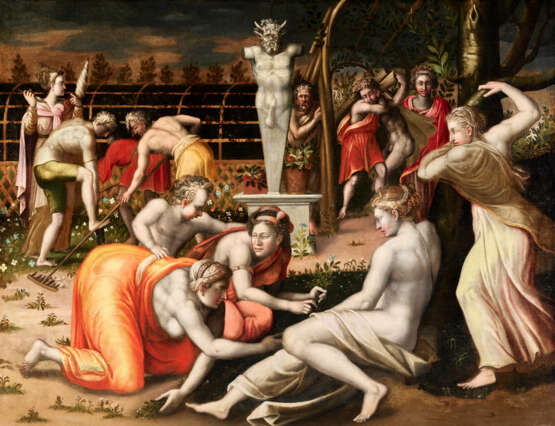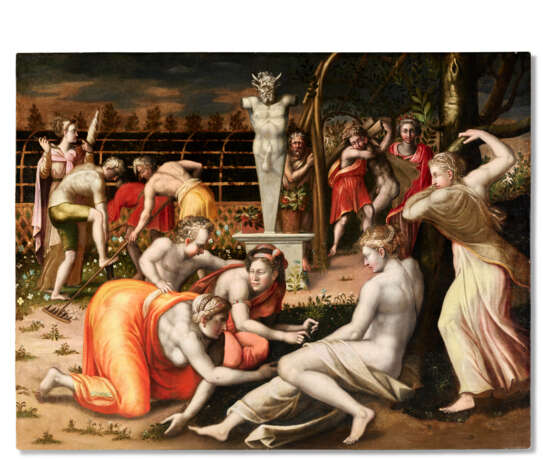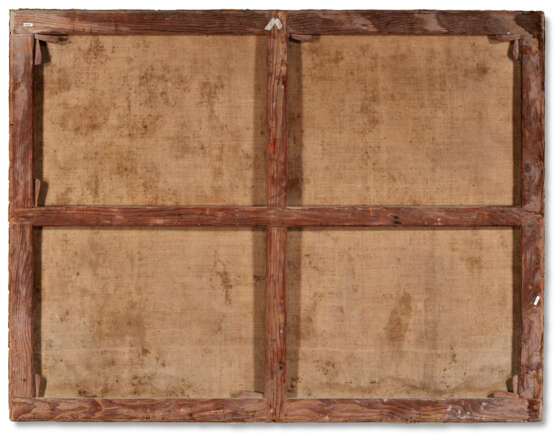ID 1164392
Lot 40 | ÉCOLE DE FONTAINEBLEAU DU XVIe SIÈCLE, ENTOURAGE DE FRANCESCO PRIMATICCIO DIT LE PRIMATICE
Valeur estimée
€ 80 000 – 120 000
L'union féconde de Vertumne et Pomone, d'après le Primatice (1503-1570) pour le pavillon de Pomone à Fontainebleau
porte l'inscription 'Duplecit Peincit' (au revers du châssis)
huile sur toile, sans cadre
145,6 x 189,2 cm. (57 1⁄3 x 74 ½ in.)
Provenance
Collection particulière depuis la fin du XIXe siècle (selon Gismondi, 2010, op. cit. infra).
Vente anonyme, hôtel des ventes de Nice Riviéra, Nice, 28 novembre 2009, (Mes Wetterwald & Rannou-Cassegrain), lot 13 (comme 'école française de la deuxième moitié du XVIe siècle, suiveur de Primatice').
Literature
R. Bacou, S. Béguin, in S. Béguin, L'école de Fontainebleau, cat. exp., Paris, galeries nationales d'exposition du Grand Palais, 1972-1973, p. 137, sous le n°145.
L. Golson, 'Rosso Fiorentino au Pavillon de Pomone', in A. Chastel (dir.), actes du colloque L'art de Fontainebleau, Paris, 1975, p. 231.
E. A. Carroll, Rosso Fiorentino. Drawings, Prints, and Decorative Arts, cat. exp., Washington, National Gallery of Art, 1987-1988, p. 201, sous la note 15.
D. Cordellier, 'Le pavillon de Pomone à Fontainebleau 1541-1543 (?)', in D. Cordellier, Primatice, maître de Fontainebleau 1504-1570, cat. exp., Paris, musée du Louvre, 2004-2005, p. 210, sous la note 15.
Anonyme, 'La semaine prochaine sous le marteau', La gazette de l'hôtel Drouot, 20 novembre 2009, 40, p. 209, reproduit en couleurs.
Anonyme, 'Pomone bellifontaine', La gazette de l'hôtel Drouot, 4 décembre 2009, 42, p. 223, reproduit en couleurs.
Gismondi, Les Amours de Vertumne et Pomone, cat. exp., Paris, Grand Palais, Biennale des Antiquaires, 2010.
C. Occhipinti, 'Su L'unione feconda di Vertumno e Pomona della Galerie Gismondi. Primaticcio e Rosso e la cultura artistica di Fontainebleau', in Primaticcio e le arti alla corte di Francia, actes du colloque, Horti Hesperidum. Studi di storia del collezionismo e della storiografia artistica, Rome, 2011, II, pp. 33-64, reproduit en couleurs pp. 61-63.
L. Armando, 'Restauration et problèmes de formats' (trad. L. Armando), in Primaticcio et Rosso. A propos de l'union féconde de Vertumne et Pomone de la galerie Gismondi, Horti Hesperidum studi di storia del collezionismo e della storiografia artistica, Rome, 2012 (réédition de 2011), II, pp. 53-61, reproduit en couleurs pp. 39-52, 62-65 et p. 67.
C. Occhipinti, L'arte in Italia e in Europa nel secondo Cinquecento, Turin, 2012, p. 79, reproduit en noir et blanc p. 81.
C. Occhipinti, 'A propos de l'Union féconde de Vertumne et Pomone de la galerie Gismondi. Primatice et Rosse et la culture aristique de Fontainebleau' (trad. L. Armando), in Primaticcio et Rosso. A propos de l'union féconde de Vertumne et Pomone de la galerie Gismondi, Horti Hesperidum studi di storia del collezionismo e della storiografia artistica, Rome, 2012, II, pp. 11-38, reproduit en couleurs pp. 39-52, 62-65 et p. 6.
C. Occhipinti, 'Concerning Galerie Gismondi's Fruitful union of Vertumnus and Pomona' (trad. L. Comoy), in Primaticcio et Rosso. Concerning Galerie Gismondi's 'Fruitful union of Vertumnus and Pomona', Horti Hesperidumstudi di storia del collezionismo e della storiografia artistica, Rome, 2012, pp. 11-35, reproduit en couleurs.
C. Occhipinti, 'Fontainebleau, le paragone et le souvenir de Léonard de Vinci', in F. Elsig (dir.), Peindre en France à la Renaissance, Milan, 2012, II, pp. 31-33, reproduit en noir et blanc p. 22, p. 30 et p. 33.
L. Armando, 'Restoration and problems of formats' (trad. L. Comoy), in Primaticcio et Rosso. Concerning Galerie Gismondi's 'Fruitful union of Vertumnus and Pomona', Horti Hesperidumstudi di storia del collezionismo e della storiografia artistica, Rome, 2012, pp. 53-59, reproduit en couleurs.
X. Salmon, Fontainebleau. Le temps des Italiens, Gand-Courtrai, 2013, p. 41.
C. Occhipinti, 'Ricognizioni su Léon Davent', Horti Hesperidum studi di storia del collezionismo e della storigrafia artistica, Rome, 2017, VIII, p. 61, reproduit en couleurs p. 72.
Gismondi, Peintures et dessins bellifontains, Paris, 2020, pp. 4-35.
N. Gural, 'Peek Into The Most Grandiose Booths At TEFAF Maastricht, The World-Leading Art Fair', Forbes, [en ligne], 6 mars 2020, https://www.forbes.com/sites/natashagural/2020⁄03/06/peek-into-the-most-grandiose-booths-at-tefaf-maastricht-before-the-world-leading-art-fair-opens-to-the-public/.
Exhibited
Maastricht, MECC, The European Fine Art Foundation (TEFAF), 7-15 mars 2020.
Further details
SCHOOL OF FONTAINEBLEAU, 16th CENTURY, CIRCLE OF FRANCESCO PRIMATICCIO, THE FRUITFUL UNION OF VERTUMNUS AND POMONA AFTER THE FRESCO IN POMONA'S PAVILLION AT FONTAINEBLEAU, OIL ON CANVAS, UNFRAMED
The School of Fontainebleau represents one of the most singular periods in the history of art. It takes its name from the château south of Paris, where artists from all the major European artistic centres gathered in the early 16th century to transform an ancient feudal residence into that of a humanist prince. Rarely has an artistic project been so comprehensive and so clearly modern. King François I (1494-1547) wanted to use the arts to elevate his kingdom to the level of his Italian neighbours. The art produced at Fontainebleau bears witness to his creative fever and highlights the speaks to the hedonistic desires of his age: glory, pleasure, love and festivities.
The artists Giovanni Battista di Jacopo, known as Rosso Fiorentino (1495-1540) and Francesco Primaticcio (1504-1570) were the true stewards of this transformation. To them we owe the Galerie François I, begun by the former and completed by the latter, a veritable manifesto of the Mannerist school of the French Renaissance. Unfortunately, not all of their creations have survived to the present day. The Galerie d'Ulysse disappeared in 1738, and the Pavillon de Pomone was destroyed in 1766. This latter was a small folly in the gardens of the chateau, situated near the Grotte des PinsIt was constructed on a single level, open on two sides to the gardens and enclosed on the other two by frescoed walls, one of which was executed by Rosso Fiorentino and the other by Primatice.
An engraving by Léon Davent (active between 1540 and 1556) (Paris, Blibliothèque nationale de France, département des estampes et de la photographie, inv. no. da67) based on Primaticcio's composition, and another by Antonio Fantuzzi (1510-1550) based on Rosso's, help us to understand the relationship between the two frescoes. Set in the heart of a garden, these compositions evoke the wonderfully botanical myth of Vertumne and Pomona. Taken from Ovid (43 B.C.-17 or 18), the story recounts the seduction of the fruit nymph Pomona, who is seduced by Vertumne, who disguises himself as a grape-picker, a vine keeper, a fisherman and finally an old woman in order to approach her; each successive character also being symbolic of the passing seasons.
While Rosso's composition aptly depicts the most frequently illustrated element of the metamorphosis, that of the old woman, Vertumne, approaching the chaste Pomona, Primaticcio's composition is harder to decipher. It has been referred to variously as: 'Nymphs cultivating a garden', 'The temple of Priape', because of the central presence of the divinity equated with fecundity, symbolized by a statue of the god in erection, 'The garden of Pomona', and 'The fertile union of Vertumne and Pomona'. A 1539 translation of Ovid's text may have inspired Primaticcio to create this singular composition. Unlike the usual translations, the text describes Pomona busy removing weeds from her garden, and mentions trees so heavy with fruit that columns were needed to support them (Les XV livres de la Métamorphose d'Ovide, 1539, XIV, f°. 96-98).
If we owe our knowledge of these two compositions to engravings, the present painting is a particularly important piece of visual evidence relating to the School of Fontainebleau. Here, we rediscover the stony complexions of the nymphs, inspired by Primaticcio's study of Michelangelo’s (1475-1564) paintings, and the acidic palette of ochre and orange tones that underline a certain notion of eroticism.
| Technique appliquée: | Huile sur toile |
|---|---|
| Style artistique: | Vieux Maître |
| Genre: | Peinture mythologique |
| Lieu d'origine: | Europe de l'Ouest, France, Europe |
| Catégorie maison de vente aux enchères: | Peintures, Aquarelles, Dessins, Peintures |
| Technique appliquée: | Huile sur toile |
|---|---|
| Style artistique: | Vieux Maître |
| Genre: | Peinture mythologique |
| Lieu d'origine: | Europe de l'Ouest, France, Europe |
| Catégorie maison de vente aux enchères: | Peintures, Aquarelles, Dessins, Peintures |
| Adresse de l'enchère |
CHRISTIE'S 9 Avenue Matignon 75008 Paris France | ||||||||||||||
|---|---|---|---|---|---|---|---|---|---|---|---|---|---|---|---|
| Aperçu |
| ||||||||||||||
| Téléphone | +33 (0)1 40 76 85 85 | ||||||||||||||
| Fax | +33 (0)1 40 76 85 86 | ||||||||||||||
| Conditions d'utilisation | Conditions d'utilisation | ||||||||||||||
| transport |
Service postal Service de messagerie ramassage par vous-même | ||||||||||||||
| Modes de paiement |
Virement bancaire | ||||||||||||||
| Heures d'ouverture | Heures d'ouverture
|





